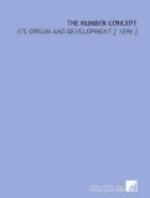netat, 1,
naes, 2,
naesa netat,
3; and so on through a long list of tribes whose numeral
scales are equally scanty. A still larger number
of tribes show an ability to count one step further,
to 4; but beyond this limit the majority of Australian
and Tasmanian tribes do not go. It seems most
remarkable that any human being should possess the
ability to count to 4, and not to 5. The number
of fingers on one hand furnishes so obvious a limit
to any of these rudimentary systems, that positive
evidence is needed before one can accept the statement.
A careful examination of the numerals in upwards of
a hundred Australian dialects leaves no doubt, however,
that such is the fact. The Australians in almost
all cases count by pairs; and so pronounced is this
tendency that they pay but little attention to the
fingers. Some tribes do not appear ever to count
beyond 2—a single pair. Many more
go one step further; but if they do, they are as likely
as not to designate their next numeral as two-one,
or possibly, one-two. If this step is taken,
we may or may not find one more added to it, thus completing
the second pair. Still, the Australian’s
capacity for understanding anything which pertains
to number is so painfully limited that even here there
is sometimes an indefinite expression formed, as many,
heap, or plenty, instead of any distinct numeral;
and it is probably true that no Australian language
contains a pure, simple numeral for 4. Curr, the
best authority on this subject, believes that, where
a distinct word for 4 is given, investigators have
been deceived in every case.[32] If counting is carried
beyond 4, it is always by means of reduplication.
A few tribes gave expressions for 5, fewer still for
6, and a very small number appeared able to reach
7. Possibly the ability to count extended still
further; but if so, it consisted undoubtedly in reckoning
one pair after another, without any consciousness
whatever of the sum total save as a larger number.
The numerals of a few additional tribes will show
clearly that all distinct perception of number is
lost as soon as these races attempt to count above
3, or at most, 4. The Yuckaburra[33] natives can
go no further than wigsin, 1, bullaroo,
2, goolbora, 3. Above here all is referred
to as moorgha, many. The Marachowies[34]
have but three distinct numerals,—cooma,
1, cootera, 2, murra, 3. For 4 they
say minna, many. At Streaky Bay we find
a similar list, with the same words, kooma
and kootera, for 1 and 2, but entirely different
terms, karboo and yalkata for 3 and
many. The same method obtains in the Minnal Yungar
tribe, where the only numerals are kain, 1,
kujal, 2, moa, 3, and bulla,
plenty. In the Pinjarra dialect we find doombart,
1, gugal, 2, murdine, 3, boola,
plenty; and in the dialect described as belonging to




